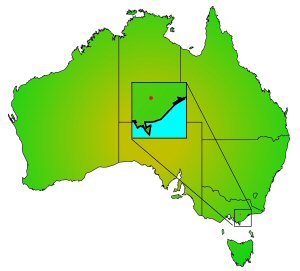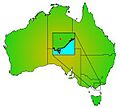West Gippsland galaxias facts for kids
Quick facts for kids West Gippsland galaxias |
|
|---|---|
| Conservation status | |
|
Critically Endangered (ASFB)
|
|
| Scientific classification | |
| Genus: |
Galaxias
|
| Species: |
longifundus
|
The West Gippsland galaxias (scientific name: Galaxias longifundus) is a special type of freshwater fish. It belongs to a group of fish called galaxiids, which are found in Australia. This fish is part of a larger group known as the Mountain Galaxias species complex.
Contents
About the West Gippsland Galaxias
What Does It Look Like?
The West Gippsland galaxias is usually about 6.5 to 8 centimeters (about 2.5 to 3 inches) long. The biggest one ever found was about 9.7 centimeters (almost 4 inches) long.
This fish has a long body that is quite deep. Its back is a bit flat near its belly fins. Its head is a medium size, a little wider than it is deep, and looks like a wedge from the side. The front of its face, called the snout, is not too long and has a rounded shape.
Fins and Colors
The fins of this fish have a slightly fleshy base, especially the ones on its back and belly. All its fins are rounded. The fin on its back (dorsal fin) and the fin on its underside (anal fin) are about the same length, though the dorsal fin is usually a bit longer. Its belly fins (pelvic fins) are located about halfway along its body, and its side fins (pectoral fins) look like small paddles. The tail fin is special because it has small flaps that extend from the narrow part of its body (caudal peduncle) almost to the end of the fin rays.
The West Gippsland galaxias is mostly olive-brown on its back, head, and upper sides. This color fades to light brown on its lower sides and becomes creamy white on its belly. It has dark spots and blotches all over its body, and you might see a faint line of golden sparkles along its middle sides. The gill cover is see-through, with a small golden spot. Its fins are a see-through olive-grey color.
Where Does It Live?
This fish has only been found in one specific place: the east branch of Rintoul Creek. This creek is part of the La Trobe River system in Victoria, Australia. It lives at an elevation of about 195 to 275 meters (about 640 to 900 feet) above sea level.
Scientists haven't found this fish further downstream in the creek, where other fish like introduced trout now live. They also haven't found it in other nearby creeks. Old museum records from the early 1900s suggest that this species might have lived in more parts of the La Trobe River system in the past, possibly even as far downstream as Traralgon.
Its Home in the Water
The creek where the West Gippsland galaxias lives is quite small. It's usually about 2 meters (about 6.5 feet) wide and 50 centimeters (about 20 inches) deep. The creek has deeper areas called pools, which are about 90 centimeters (about 3 feet) deep on average. Between these pools are shallow, fast-flowing areas called riffles, which are only about 5 centimeters (about 2 inches) deep.
The bottom of the creek is mostly made up of large rocks (boulders), smaller rounded stones (cobbles), and pebbles. There are also smaller areas with gravel, sand, and clay. The fish can find places to hide among the rocks, under fallen branches and logs, and under overhanging banks and plants along the water's edge.
Life Cycle and Reproduction
The West Gippsland galaxias spends its entire life in freshwater. Unlike some other galaxias species, it does not go to the ocean at any point in its life.
We don't know exactly when this fish breeds, but scientists believe it happens during the spring season.
Conservation Status
The West Gippsland galaxias is considered critically endangered. This means it is at a very high risk of becoming extinct in the wild. It is protected by a law in Victoria called the Flora and Fauna Guarantee Act of 1988, which helps to protect plants and animals that are in danger.
Images for kids



